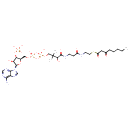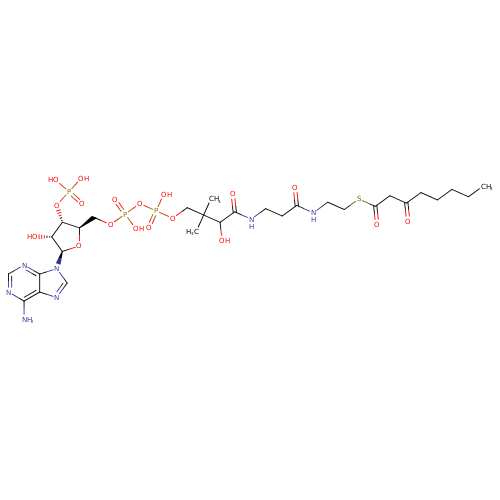|
Record Information |
|---|
| Version |
1.0 |
|---|
| Update Date |
1/22/2018 11:54:54 AM |
|---|
|
Metabolite ID | PAMDB120027 |
|---|
|
Identification |
|---|
| Name: |
3-oxooctanoyl-CoA |
|---|
| Description: | An acyl-CoA(4−) oxoanion arising from deprotonation of the phosphate and diphosphate OH groups of 3-oxooctanoyl-CoA; major species at pH 7.3. |
|---|
|
Structure |
|
|---|
| Synonyms: | - 3-ketooctanoyl-CoA(4−)
- 3-oxooctanoyl-CoA
|
|---|
|
Chemical Formula: |
C29H44N7O18P3S |
|---|
| Average Molecular Weight: |
903.684 |
|---|
| Monoisotopic Molecular
Weight: |
907.1989 |
|---|
| InChI Key: |
WPIVBCGRGVNDDT-CECATXLMSA-J |
|---|
| InChI: | InChI=1S/C29H48N7O18P3S/c1-4-5-6-7-17(37)12-20(39)58-11-10-31-19(38)8-9-32-27(42)24(41)29(2,3)14-51-57(48,49)54-56(46,47)50-13-18-23(53-55(43,44)45)22(40)28(52-18)36-16-35-21-25(30)33-15-34-26(21)36/h15-16,18,22-24,28,40-41H,4-14H2,1-3H3,(H,31,38)(H,32,42)(H,46,47)(H,48,49)(H2,30,33,34)(H2,43,44,45)/p-4/t18-,22-,23-,24+,28-/m1/s1 |
|---|
| CAS
number: |
54684-64-9 |
|---|
| IUPAC Name: | 3'- phosphonatoadenosine 5'- phosphonatoadenosine 5'- {3- {3- [(3R)- [(3R)- 3- 3- hydroxy- hydroxy- 2,2- 2,2- dimethyl- dimethyl- 4- 4- oxo- oxo- 4- 4- {[3- {[3- oxo- oxo- 3- 3- ({2- ({2- [(3- [(3- oxooctanoyl)sulfanyl]ethyl}amino)propyl]amino}butyl] diphosphate} oxooctanoyl)sulfanyl]ethyl}amino)propyl]amino}butyl] diphosphate} |
|---|
|
Traditional IUPAC Name: |
[(2R,3S,4R,5R)-5-(6-aminopurin-9-yl)-4-hydroxy-2-[({hydroxy[hydroxy(3-hydroxy-2,2-dimethyl-3-{[2-({2-[(3-oxooctanoyl)sulfanyl]ethyl}carbamoyl)ethyl]carbamoyl}propoxy)phosphoryl]oxyphosphoryl}oxy)methyl]oxolan-3-yl]oxyphosphonic acid |
|---|
| SMILES: | CCCCCC(=O)CC(=O)SCCNC(=O)CCNC(C(O)C(C)(C)COP([O-])(=O)OP([O-])(=O)OCC1(C(OP(=O)([O-])[O-])C(O)C(O1)N3(C=NC2(C(N)=NC=NC=23))))=O |
|---|
|
Chemical Taxonomy |
|---|
|
Taxonomy Description | This compound belongs to the class of chemical entities known as 3-oxo-acyl coas. These are organic compounds containing a 3-oxo acylated coenzyme A derivative. |
|---|
|
Kingdom |
Chemical entities |
|---|
| Super Class | Organic compounds |
|---|
|
Class |
Lipids and lipid-like molecules |
|---|
| Sub Class | Fatty Acyls |
|---|
|
Direct Parent |
3-oxo-acyl CoAs |
|---|
| Alternative Parents |
|
|---|
| Substituents |
- Coenzyme a or derivatives
- Purine ribonucleoside 3',5'-bisphosphate
- Purine ribonucleoside bisphosphate
- Purine ribonucleoside diphosphate
- Pentose phosphate
- Pentose-5-phosphate
- Ribonucleoside 3'-phosphate
- Beta amino acid or derivatives
- Glycosyl compound
- N-glycosyl compound
- Pentose monosaccharide
- Organic pyrophosphate
- 6-aminopurine
- Monosaccharide phosphate
- Purine
- Imidazopyrimidine
- Aminopyrimidine
- Monoalkyl phosphate
- Fatty amide
- Monosaccharide
- Pyrimidine
- 1,3-dicarbonyl compound
- N-acyl-amine
- N-substituted imidazole
- Organic phosphoric acid derivative
- Primary aromatic amine
- Alkyl phosphate
- Phosphoric acid ester
- Imidolactam
- Azole
- Imidazole
- Heteroaromatic compound
- Oxolane
- Amino acid or derivatives
- Carbothioic s-ester
- Carboxamide group
- Thiocarboxylic acid ester
- Ketone
- Secondary carboxylic acid amide
- Secondary alcohol
- Oxacycle
- Sulfenyl compound
- Carboxylic acid derivative
- Azacycle
- Thiocarboxylic acid or derivatives
- Organoheterocyclic compound
- Organic oxide
- Organic nitrogen compound
- Organooxygen compound
- Primary amine
- Carbonyl group
- Organic oxygen compound
- Organopnictogen compound
- Alcohol
- Amine
- Organosulfur compound
- Organonitrogen compound
- Hydrocarbon derivative
- Aromatic heteropolycyclic compound
|
|---|
| Molecular Framework |
Aromatic heteropolycyclic compounds |
|---|
| External Descriptors |
|
|---|
|
Physical Properties |
|---|
| State: |
Solid |
|---|
| Charge: | -4 |
|---|
|
Melting point: |
Not Available |
|---|
| Experimental Properties: |
| Property | Value | Reference |
|---|
| Melting Point | Not Available | Not Available | | Boiling Point | Not Available | Not Available | | Water Solubility | Not Available | Not Available | | LogP | -2.164 | Not Available |
|
|---|
| Predicted Properties |
|
|---|
|
Biological Properties |
|---|
| Cellular Locations: |
Not Available |
|---|
| Reactions: | |
|---|
|
Pathways: |
|
|---|
|
Spectra |
|---|
| Spectra: |
|
|---|
|
References |
|---|
| References: |
- Antonenkov VD, Van Veldhoven PP, Waelkens E, Mannaerts GP: Substrate specificities of 3-oxoacyl-CoA thiolase A and sterol carrier protein 2/3-oxoacyl-CoA thiolase purified from normal rat liver peroxisomes. Sterol carrier protein 2/3-oxoacyl-CoA thiolase is involved in the metabolism of 2-methyl-branched fatty acids and bile acid intermediates. J Biol Chem. 1997 Oct 10;272(41):26023-31. [9325339 ]
|
|---|
| Synthesis Reference: |
Thorpe, Colin. A method for the preparation of 3-ketoacyl-CoA derivatives. Analytical Biochemistry (1986), 155(2), 391-4. |
|---|
| Material Safety Data Sheet (MSDS) |
Not Available |
|---|
|
Links |
|---|
| External Links: |
|
|---|


